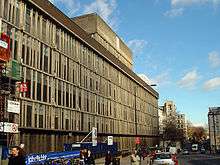Bristol Royal Infirmary
| Bristol Royal Infirmary | |
|---|---|
| University Hospitals Bristol NHS Foundation Trust | |
 Bristol Royal Infirmary (BRI) Looking north-east along Marlborough Street with the BRI hospital on the left. | |
 Shown in Bristol | |
| Geography | |
| Location | Bristol, England, United Kingdom |
| Coordinates | 51°27′34″N 2°35′46″W / 51.4594°N 2.5960°WCoordinates: 51°27′34″N 2°35′46″W / 51.4594°N 2.5960°W |
| Organisation | |
| Care system | Public NHS |
| Hospital type | Teaching |
| Affiliated university | University of Bristol, Faculty of Health and Social Care University of the West of England |
| Services | |
| Emergency department | Yes Accident & Emergency |
| Speciality | Cardiothoracic services for the South West region, Adult Cystic Fibrosis centre for Severn |
| History | |
| Founded | 1735 |
| Links | |
| Website | http://www.uhbristol.nhs.uk |
| Lists | Hospitals in England |
The Bristol Royal Infirmary, also known as the BRI, is a large teaching hospital situated in the centre of Bristol, England. It has links with the nearby University of Bristol and the Faculty of Health and Social Care at the University of the West of England, also in Bristol. It is currently undergoing a major redevelopment.
The BRI is one of eight hospitals within the University Hospitals Bristol NHS Foundation Trust. It is located next to the Bristol Royal Hospital for Children.
History

The BRI is one of the oldest Infirmaries in the United Kingdom.[1] A wealthy city merchant, Paul Fisher, was prominent in the foundation of the hospital in 1735. In 1904 Sir George White, who gave Bristol its first electric tramway service and established what was to become the Bristol Aeroplane Company, saved the hospital from debts of over £15,000 by increasing the number of subscribed donors and planning a fundraising carnival at Bristol Zoo.[2] White was appointed president of the hospital in 1906. Recognising the need to modernise the hospital building to keep up with innovations in science and medicine, he established a £50,000 fund to build a new hospital building.[3] As a result, the new Edward VII Memorial Wing designed by Charles Holden was completed in 1912.
Acquired by the National Health Service in 1948, the hospital's facilities were greatly extended in the 1960s. The Queen's Building extension opened in 1972. The Bristol Haematology and Oncology Centre, located behind the main hospital building, opened in 1971.
Notable former medical staff include Geoffrey Tovey, serologist and founder of the UK Transplant Service.
Archives
The archives of the Bristol Royal Infirmary are held at Bristol Archives (Ref. 35893) (online catalogue). The School of Nursing (Ref. 38973) (online catalogue, (online catalogue), records of surgery and the dispensary (Ref. 38990) (online catalogue) and records relating to the 1991 inquiry into children’s heart surgery at the infirmary (Ref. 45591) (online catalogue) are also held at Bristol Archives, as well as photographs (Ref. 40660) (online catalogue). A substantial quanity of material about the history of the infirmary can be found in papers collected by the surgeon Richard Smith (Ref. 35893/36) (online catalogue) and (Ref. 14754) (online catalogue)
Redevelopment
In April 2011, The Board of University Hospitals Bristol approved the £80 million redevelopment of the BRI, consisting of a new ward block on the Terrell Street behind the BRI, the refurbishment of the Queen's building, the conversion of wards in the King Edward building and decommissioning of the Old Building.[4] In September 2011, it was announced that Laing O'Rourke had signed a contract to redevelop the BRI and the extension of Bristol Royal Hospital for Children.
The redevelopment project will culminate in purpose built medical and elderly care admissions units; a state-of-the-art intensive care unit; a surgical floor; and a helipad on the roof of the Queen's Building. The BRI redevelopment aims to provide the state of the art clinical building, which will see the transfer of inpatient services from the Old Building[5] which dates from 1735.
The redevelopment will also include building a new welcome centre at the main entrance of the BRI and a new facade for the Queen's building, which was once voted one of the ugliest buildings in Bristol, is expected to be completed by summer 2016. The construction began on the new BRI ward block in March 2011, with the demolition of the old buildings on Terrell Street. It is expected to be fully open by 2015.[6][7] The newly completed Welcome Centre was opened to the public in December 2013.[8] In May 2014, a new helipad became fully operational and will receive air ambulances from Bristol and the surrounding area, which will speed up transfer times for patients who are air lifted to the hospital. The HELP Appeal supported the construction of the helipad with a grant of £500,000.[9]
Bristol heart scandal
The Bristol heart scandal, which resulted in the deaths of a number of babies and young children during heart surgery (1984–1995) led to the Kennedy Report[10] into paediatric cardiac surgical services at the hospital. The report led to greater emphasis on clinical governance within the NHS and the publication of the performance ratings of individual heart surgeons.
See also
References
- ↑ A history of the Bristol Royal Infirmary (1917). George Munro Smith.
- ↑ A History of the Royal Infirmary, Arrowsmith Publishing, 1917, p416
- ↑ p417
- ↑ "Who We Are and What We Do | University Hospitals Bristol NHS Foundation Trust". Uhbristol.nhs.uk. 27 September 2011. Retrieved 17 March 2013.
- ↑ "Redevelopment projects | University Hospitals Bristol NHS Foundation Trust". Uhbristol.nhs.uk. Retrieved 17 March 2013.
- ↑ http://www.uhbristol.nhs.uk/about-us/major-projects/milestones/
- ↑ Emma Grimshaw (11 November 2014). "The end of an era as old makes way for new at historic BRI". Bristol Post. Retrieved 22 February 2015.
- ↑ http://www.uhbristol.nhs.uk/about-us/major-projects/bri-redevelopment/welcome-centre/
- ↑ http://www.uhbristol.nhs.uk/about-us/major-projects/bri-redevelopment/helipad/
- ↑ Official Inquiry Website (in The UK Government Web Archive)